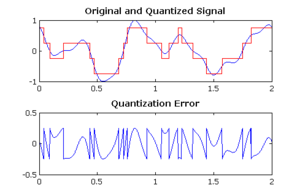Quantization error: Difference between revisions
| Line 38: | Line 38: | ||
{{listen|filename=Quantization_noise.ogg|title=Quantization Noise|description=An example of audio with progressively worsening quantization noise.|format=[[Ogg]]}} |
{{listen|filename=Quantization_noise.ogg|title=Quantization Noise|description=An example of audio with progressively worsening quantization noise.|format=[[Ogg]]}} |
||
Now here is where it gets interesting. The calculations above assume that you have fully stuffed your ADC. That is essentially the loudest passage in a sound of music. What happens during the quiet passages where perhaps only 4 bits are being used? That relative quantization distortion is huge. To get around this issue analog compressors and expanders can be added, but then they themselves introduce large amounts of distortion especially if the compressor does not match the expander. |
|||
==References== |
==References== |
||
Revision as of 16:59, 22 April 2009
The difference between the actual analog value and quantized digital value due is called quantization error. This error is due either to rounding or truncation.
Many physical quantities are actually quantized by physical entities. Examples of fields where this limitation applies include electronics (due to electrons), optics (due to photons), biology (due to DNA), and chemistry (due to molecules). This is sometimes known as the "quantum noise limit" of systems in those fields. This is a different manifestation of "quantization error," in which theoretical models may be analog but physics occurs digitally. Around the quantum limit, the distinction between analog and digital quantities vanishes.
Quantization noise model of quantization error

Quantization noise is a model of quantization error introduced by quantization in the analog-to-digital conversion (ADC) in telecommunication systems and signal processing. It is a rounding error between the analog input voltage to the ADC and the output digitized value. The noise is non-linear and signal-dependent. It can be modelled in several different ways.
In an ideal analog-to-digital converter, where the quantization error is uniformly distributed between −1/2 LSB and +1/2 LSB, and the signal has a uniform distribution covering all quantization levels, the signal-to-noise ratio (SNR) can be calculated from
The most common test signals that fulfil this are full amplitude triangle waves and sawtooth waves.
In this case a 16-bit ADC has a maximum signal-to-noise ratio of 6.0206 × 16 = 96.33 dB.
When the input signal is a full-amplitude sine wave the distribution of the signal is no longer uniform, and the corresponding equation is instead
Here, the quantization noise is once again assumed to be uniformly distributed. When the input signal has a high amplitude and a wide frequency spectrum this is the case.[1] In this case a 16-bit ADC has a maximum signal-to-noise ratio of 98.09 dB. The 1.761 difference in signal-to-noise only occurs due to the signal being a full-scale sine wave instead of a triangle/sawtooth.
For complex signals in high-resolution ADCs this is an accurate model. For low-resolution ADCs, low-level signals in high-resolution ADCs, and for simple waveforms the quantization noise is not uniformly distributed, making this model inaccurate.[2] In these cases the quantization noise distribution is strongly affected by the exact amplitude of the signal.
Now here is where it gets interesting. The calculations above assume that you have fully stuffed your ADC. That is essentially the loudest passage in a sound of music. What happens during the quiet passages where perhaps only 4 bits are being used? That relative quantization distortion is huge. To get around this issue analog compressors and expanders can be added, but then they themselves introduce large amounts of distortion especially if the compressor does not match the expander.
References
- ^ Pohlman, Ken C. (1989). Principles of Digital Audio 2nd Edition. SAMS. p. 60.
- ^ okelloto, tom (2001). The Art of Digital Audio 3rd Edition. Focal Press. ISBN 0240515870.
See also
- Round-off error
- Dither
- Analog to digital converter
- Quantization
- Discretization error
- Signal-to-noise ratio
- Bit resolution
- SQNR
External links
- Quantization noise in Digital Computation, Signal Processing, and Control, Bernard Widrow and István Kollár, 2007.
- The Relationship of Dynamic Range to Data Word Size in Digital Audio Processing
- Round-Off Error Variance — derivation of noise power of q²/12 for round-off error
- Dynamic Evaluation of High-Speed, High Resolution D/A Converters Outlines HD, IMD and NPR measurements, also includes a derivation of quantization noise
- Signal to quantization noise in quantized sinusoidal


